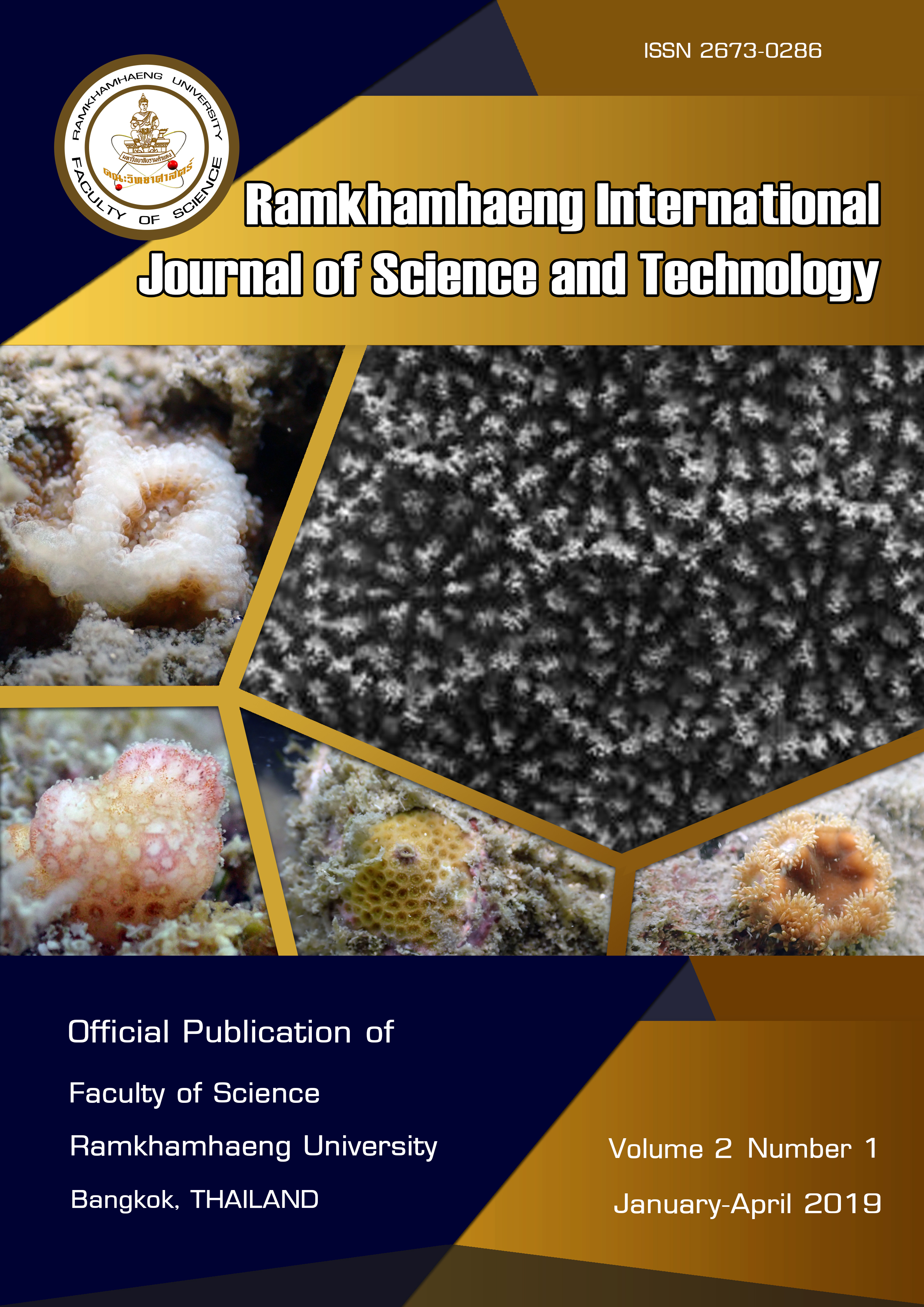Comparing microplastic contamination in bivalves (Siliqua radiata) collected from Hat Laem Son, Satun Province, and Hat Pakmeng, Trang Province
Keywords:
microplastic, contamination, Siliqua radiata, Andaman SeaAbstract
Microplastic contamination in marine biota is an important and interesting issue at both national and international levels. It becomes one of the major causes of marine pollution that continuously impacts marine ecosystems, particularly carrying toxic substances that accumulate in marine organisms through food webs. The study on microplastic contamination in the sunset calm, Siliqua radiata, the economically important bivalve found along the Andaman coast of Thailand, is highly required in order to comprehend the plastic impacts in marine ecosystems. This study compared the microplastic contamination in S. radiata collected from Hat Laem Son, Satun Province, and Hat Pak Meng, Trang Province. The samples were digested with 30% hydrogen peroxide solution before separating microplastics by floating in saturated sodium chloride solution, then filtering with a paper filter. Our analysis revealed that the mean densities of microplastics found in the sunset calm collected from Satun and Trang Provinces were about 6 and 8 particles/individual, respectively. Microplastics were mostly found between the size range of 1,001 – 2,000 µm. and were colorless fibers. This study highlights the microplastics contamination in S. radiata in the Andaman Sea, reflecting the needs for continued monitoring on microplastics accumulation in coastal environments.
References
Browne MA, Galloway T, Thompson R (2007) Microplastic – an emerging contaminant of potential concern?. Integrated Environmental Assessment and Management 3(4): 559–561
De Witte B, Devriese L, Bekaert K, Hoffman, S, Vandermeersch G, Cooreman K, & Robbens J (2014) Quality assessment of the blue mussel (Mytilus edulis): Comparison between commercial and wild types. Marine pollution bulletin 85(1): 146-155
do Sul JAI & Costa MF (2014) The present and future of microplastic pollution in the marine environment. Environmental pollution 185: 352-364
Jambeck JR, Geyer R, Wilcox C, Siegler TR, Perryman M, Andrady A, Narayan R, Law KL (2015) Plastic waste inputs from land into the ocean. Science 347: 768–771
Jang M, Shim WJ, Han GM, Song YK, & Hong SH (2018) Formation of microplastics by polychaetes (Marphysa sanguinea) inhabiting expanded polystyrene marine debris. Marine pollution bulletin 131: 365-369
Jungrak L, Yeemin T, Sutthacheep M, Aunkhongthong W, Chamchoy C, Prickchoopon T, Niyomthai P (2018) Microplastics in the wedge clam Donax scortum from Hat Pak Meng, Trang Province. In: Proceedings of 44th Congress on Science and Technology of Thailand (STT 44). October 29 - 31, 2018, Bangkok, Thailand 342-346 p
Karlsson TM, Vethaak AD, Almroth BC, Ariese F, van Velzen M, Hassellöv M & Leslie HA (2017) Screening for microplastics in sediment, water, marine invertebrates and fish: method development and microplastic accumulation. Marine pollution bulletin 122(1-2): 403-408
Kershaw PJ & Rochman CM (2015) Sources, fate and effects of microplastics in the marine environment: part 2 of a global assessment. Reports and Studies-IMO/FAO/Unesco-IOC/WMO/IAEA/UN/UNEP Joint Group of Experts on the Scientific Aspects of Marine Environmental Protection (GESAMP) Eng No. 93
Li J, Lusher AL, Rotchell JM, Deudero S, Turra A, Bråte ILN, Sun C, Hossain MS, Li Q, Kolandhasamy P & Shi H (2019) Using mussel as a global bioindicator of coastal microplastic pollution. Environmental pollution 244: 522-533
Li J, Yang D, Li L, Jabeen K, & Shi H (2015) Microplastics in commercial bivalves from China. Environmental pollution 207: 190-195
Lusher AL, O'Donnell C, Officer R & O'Connor I (2016) Microplastic interactions with North Atlantic mesopelagic fish. ICES Journal of marine science 73(4): 1214-1225
Mathalon A & Hill P (2014) Microplastic fibers in the intertidal ecosystem surrounding Halifax Harbor, Nova Scotia. Marine pollution bulletin 81(1): 69-79
Murray F, & Cowie PR (2011) Plastic contamination in the decapod crustacean Nephrops norvegicus (Linnaeus, 1758). Marine pollution bulletin 62(6): 1207-1217
Naji A, Nuri M & Vethaak AD (2018) Microplastics contamination in molluscs from the northern part of the Persian Gulf. Environmental pollution 235: 113-120
Phuong NN, Poirier L, Pham QT, Lagarde F & Zalouk-Vergnoux A (2018) Factors influencing the microplastic contamination of bivalves from the French Atlantic coast: location, season and/or mode of life?. Marine Pollution Bulletin 129(2): 664-674
Plastics Europe (2017) Plastics – The Facts 2017. Plastics Europe, Brussels
Renzi M, Guerranti C & Blašković A (2018) Microplastic contents from maricultured and natural mussels. Marine pollution bulletin 131: 248-251
Rochman CM, Hoh E, Kurobe T & Teh SJ (2013) Ingested plastic transfers hazardous chemicals to fish and induces hepatic stress. Scientific reports 3(1): 1-7
Santana MFM, Ascer LG, Custódio MR, Moreira FT & Turra A. (2016) Microplastic contamination in natural mussel beds from a Brazilian urbanized coastal region: rapid evaluation through bioassessment. Marine Pollution Bulletin 106(1-2): 183-189
Van Cauwenberghe L & Janssen CR (2014) Microplastics in bivalves cultured for human consumption. Environmental pollution 193: 65-70
Wright SL, Rowe D, Thompson RC, & Galloway TS (2013) Microplastic ingestion decreases energy reserves in marine worms. Current Biology 23(23): 1031-1033
Zhao S, Zhu L & Li D (2016) Microscopic anthropogenic litter in terrestrial birds from Shanghai, China: Not only plastics but also natural fibers. Science of the Total Environment 550: 1110-1115
Zhou Q, Zhang J, Fu J, Shi J & Jiang G (2008) Biomonitoring: an appealing tool for assessment of metal pollution in the aquatic ecosystem. Analytica chimica acta 606(2): 135-150
Downloads
Published
Issue
Section
License
Copyright Notice: a copyright on any article in the published journal is retained by the Ramkhamhaeng International Journal of Science and Technology. Readers or Users grant the right to use of the Article contained in the Content in accordance with the Creative Commons CC BY-NC-ND license and the Data contained in the Content in accordance with the Creative Commons CC BY-NC-ND.



